Cooling Towers Size
Cooling Towers Market Growth Projections and Opportunities
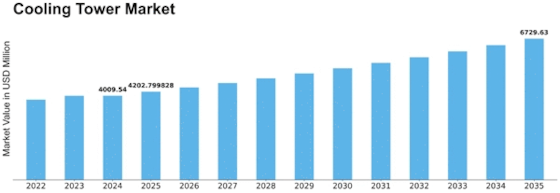
Searching...


What is the current valuation of the Cooling Tower Market as of 2024?
The Cooling Tower Market was valued at 4009.54 USD Million in 2024.
What is the projected market valuation for the Cooling Tower Market in 2035?
The market is projected to reach a valuation of 6729.63 USD Million by 2035.
What is the expected CAGR for the Cooling Tower Market during the forecast period 2025 - 2035?
The expected CAGR for the Cooling Tower Market during the forecast period 2025 - 2035 is 4.82%.
Which companies are considered key players in the Cooling Tower Market?
Key players in the Cooling Tower Market include SPX Cooling Technologies, Baltimore Air Coil, Evapco, and Trane, among others.
What are the main types of cooling towers and their market valuations?
The main types include Evaporative Cooling Towers valued between 2000.0 and 3500.0 USD Million, Dry Cooling Towers between 1200.0 and 2200.0 USD Million, and Hybrid Cooling Towers between 809.54 and 1029.63 USD Million.
How does the design segment of the Cooling Tower Market perform?
The Mechanical Draft design segment is valued between 2000.0 and 3500.0 USD Million, while the Natural Draft segment ranges from 2009.54 to 3229.63 USD Million.
As per MRFR analysis, the Cooling Tower Market Size was estimated at 4009.54 USD Million in 2024. The Cooling Tower industry is projected to grow from 4202.81 USD Million in 2025 to 6729.63 USD Million by 2035, exhibiting a compound annual growth rate (CAGR) of 4.82 during the forecast period 2025 - 2035.
The Cooling Tower Market is experiencing a transformative shift towards sustainability and technological integration.
| 2024 Market Size | 4009.54 (USD Million) |
| 2035 Market Size | 6729.63 (USD Million) |
| CAGR (2025 - 2035) | 4.82% |
| Largest Regional Market Share in 2024 | Asia Pacific |
<p>SPX Cooling Technologies (US), Baltimore Air Coil (US), <a href="https://www.evapco.com/products/cooling-towers-factory-assembled/cooling-tower">Evapco </a>(US), Thermal Care (US), <a href="https://www.trane.com/commercial/latin-america/bz/en/services/rentals/rental-equipment/cooling-towers.html">Trane</a> (US), Mitsubishi Electric (JP), Alfa Laval (SE), Babcock & Wilcox (US), Koch Industries (US)</p>
The Cooling Tower Market is currently experiencing a dynamic evolution, driven by various factors that influence its growth trajectory. Increasing industrialization and urbanization are propelling demand for efficient cooling solutions across sectors such as power generation, HVAC system, and manufacturing. Furthermore, the growing emphasis on energy efficiency and sustainability is prompting industries to adopt advanced cooling technologies. This shift not only enhances operational efficiency but also aligns with global environmental goals, suggesting a potential for innovation in cooling tower designs and materials. In addition, regulatory frameworks aimed at reducing carbon emissions are likely to shape the Cooling Tower Market landscape. As industries strive to comply with stringent environmental standards, there is a noticeable trend towards the integration of eco-friendly materials and practices in cooling tower construction and operation. This evolving market environment indicates a promising future for manufacturers who can adapt to these changing demands and invest in research and development. Overall, the Cooling Tower Market appears poised for growth, with opportunities for advancements that cater to both efficiency and sustainability needs.
The Cooling Tower Market is witnessing a notable shift towards sustainability initiatives. Companies are increasingly focusing on eco-friendly materials and energy-efficient designs to meet regulatory requirements and consumer expectations. This trend reflects a broader commitment to reducing environmental impact and promoting sustainable practices within the industry.
Technological advancements are playing a crucial role in shaping the Cooling Tower Market. Innovations in materials, design, and operational efficiency are enabling manufacturers to create more effective cooling solutions. These advancements not only enhance performance but also contribute to reduced energy consumption, aligning with the growing demand for sustainable technologies.
The integration of smart technologies into cooling tower systems is emerging as a significant trend. Automation and IoT applications are enhancing monitoring and control capabilities, leading to improved efficiency and reduced operational costs. This trend indicates a shift towards more intelligent and responsive cooling solutions that can adapt to varying operational demands.
The heightened focus on sustainability is a driving force in the Cooling Tower Market. As organizations prioritize sustainable practices, the demand for eco-friendly cooling solutions is on the rise. Cooling towers that utilize renewable energy sources or have lower environmental footprints are becoming increasingly popular. This trend is supported by consumer preferences shifting towards sustainable products and practices. Additionally, industries are recognizing the long-term benefits of investing in sustainable cooling technologies, which can lead to cost savings and improved corporate image. The emphasis on sustainability is likely to continue influencing purchasing decisions, thereby propelling the growth of the Cooling Tower Market.
The rapid pace of industrial growth and urbanization significantly influences the Cooling Tower Market. As urban areas expand and industries proliferate, the need for effective cooling solutions becomes increasingly critical. Data suggests that the industrial sector, particularly in manufacturing and power generation, is a major consumer of cooling towers, accounting for a substantial share of the market. The construction of new facilities and the expansion of existing ones necessitate the installation of cooling systems to manage heat loads effectively. This trend is expected to continue, with projections indicating a steady increase in demand for cooling towers in urbanized regions. The Cooling Tower Market is thus poised for growth, driven by the ongoing industrialization and urban development.
The increasing emphasis on energy efficiency is a primary driver for the Cooling Tower Market. As industries strive to reduce operational costs and minimize environmental impact, energy-efficient cooling solutions are becoming essential. According to recent data, energy-efficient cooling towers can reduce energy consumption by up to 30% compared to traditional models. This shift not only aligns with sustainability goals but also meets regulatory requirements in various regions. Consequently, manufacturers are innovating to produce cooling towers that utilize advanced materials and designs, enhancing their efficiency. The growing awareness of energy conservation among consumers and businesses alike further propels the demand for these systems, indicating a robust growth trajectory for the Cooling Tower Market.
Technological innovations play a crucial role in shaping the Cooling Tower Market. The advent of new materials, designs, and control systems has led to the development of more efficient and reliable cooling towers. Innovations such as variable speed drives, advanced heat exchangers, and smart monitoring systems enhance the performance and efficiency of cooling towers. These technologies not only improve energy efficiency but also extend the lifespan of cooling systems. Furthermore, the integration of IoT and automation in cooling tower operations allows for real-time monitoring and optimization, reducing maintenance costs and downtime. As industries increasingly adopt these advanced technologies, the Cooling Tower Market is expected to witness significant advancements and growth.
The stringent regulatory compliance and environmental standards are pivotal drivers for the Cooling Tower Market. Governments worldwide are implementing regulations aimed at reducing water and energy consumption, as well as minimizing emissions from industrial processes. These regulations compel industries to adopt advanced cooling technologies that comply with environmental standards. For instance, cooling towers that utilize closed-loop systems are gaining traction due to their reduced water usage and lower environmental impact. The need for compliance not only drives the demand for innovative cooling solutions but also encourages manufacturers to invest in research and development. As industries seek to meet these regulatory requirements, the Cooling Tower Market is likely to experience sustained growth.
<p>The cooling tower market is characterized by a diverse range of technologies, with evaporative cooling towers leading the segment due to their ubiquitous application across industries. This segment holds a substantial share owing to their efficiency in heat transfer through evaporation, making them essential for large-scale cooling operations in sectors such as power generation and <a href="https://www.marketresearchfuture.com/reports/smart-hvac-controls-market-22293">smart HVAC controls</a>. In contrast, dry cooling towers have catered to niche markets where water scarcity is a concern, allowing them to maintain a marginal share. Hybrid cooling towers are carving a notable space for themselves with their ability to transition between evaporative and dry cooling methods.</p>
<p>Cooling Technology: Evaporative (Dominant) vs. Hybrid (Emerging)</p>
<p>Evaporative cooling towers dominate the market as they leverage the cooling effect of water evaporation, providing superior heat reduction efficiency while being cost-effective for large industrial applications. Their widespread adoption stems from their effectiveness in optimizing thermal performance in power plants, chemical processing, and HVAC systems. Conversely, hybrid cooling towers are emerging as a versatile solution, offering the benefits of both evaporative and dry cooling. This adaptability is crucial in regions facing strict water regulations while still aiming for efficient cooling solutions. Hybrid systems, thus, represent a significant opportunity for growth, driven by increasing environmental concerns and the need for energy-efficient technologies.</p>
<p>The Cooling Tower Market exhibits a distinct segmentation by design, with the mechanical draft towers holding a significant share due to their widespread application across various industries. Mechanical draft cooling towers, known for their efficient operation and ability to handle larger cooling loads, dominate the market landscape. On the other hand, natural draft cooling towers, while currently smaller in market share, are gaining traction due to their energy-efficient designs and reduced operational costs, making them a viable alternative in specific applications.</p>
<p>Cooling Tower Design: Mechanical Draft (Dominant) vs. Natural Draft (Emerging)</p>
<p>Mechanical draft cooling towers are recognized for their robust performance, especially in industrial applications where high heat loads are common. Their design incorporates fans to enhance airflow, allowing for better heat exchange, which is crucial in cooling processes. In contrast, natural draft cooling towers rely on buoyancy for airflow, leading to lower energy consumption and operational expenses. Despite being less prevalent, the natural draft segment is projected to grow rapidly as industries seek sustainable solutions. Its low environmental impact and installation flexibility make it attractive for new projects, positioning it well for future expansion in alignment with global sustainability goals.</p>
<p>In the Cooling Tower Market, the material segment is diverse, encompassing Concrete, Steel, Fiber Reinforced Plastic (FRP), Wood, and High-Density Polyethylene (HDPE). Concrete cooling towers hold the largest share, favored for their durability and thermal efficiency. Steel cooling towers, meanwhile, are emerging rapidly, driven by the need for lightweight solutions that offer quicker installation and flexibility in design. Other materials like FRP and Wood hold smaller market shares, catering to specific applications and preferences in various industrial settings.</p>
<p>Cooling Towers Market: Concrete (Dominant) vs. Steel (Emerging)</p>
<p>Concrete cooling towers are recognized as the dominant material choice due to their robustness and longevity, making them suitable for high-capacity operations. Their ability to withstand extreme weather conditions and require minimal maintenance positions them favorably in large industrial and power generation applications. In contrast, Steel cooling towers are gaining traction as an emerging option, appreciated for their lightweight properties and customizable designs. This flexibility allows for quicker assembly and installation which is increasingly preferred in modern projects, particularly where space constraints and transportation efficiency are vital.</p>
<p>The Cooling Tower Market is segmented into several applications including Power Generation, HVACR, Food & Beverage, Chemical, Petrochemical, Oil & Gas, and Others. Among these, Power Generation holds the largest share, driven by increasing electricity demands and the operational requirements of power plants. Following closely is the HVACR sector, which has seen growing adoption due to rising global temperatures and the need for effective climate control in commercial and residential spaces.</p>
<p>Power Generation: Leading vs. HVACR: Fastest-Growing</p>
<p>Power Generation is the leading application for cooling towers, marked by its extensive use in thermal power plants where efficient cooling is critical for operations. This segment thrives on the continuous demand for electricity amidst an electrifying economy. On the other hand, HVACR represents the fastest-growing application, propelled by the booming construction industry and a shift towards energy-efficient cooling solutions. This sector focuses on delivering comfort and safety, leading to innovative cooling technologies and efficient designs that cater to diverse industrial needs.</p>
<p>In the Cooling Tower Market, the flow type segment is predominantly driven by crossflow cooling towers, which hold a significant market share due to their efficiency and effectiveness in various applications. Crossflow towers are well-suited for industrial purposes and are favored for their capacity to facilitate maintenance and operational flexibility. On the other hand, counterflow towers are increasingly gaining traction, particularly in situations requiring higher efficiency and lower operational costs. Their ability to maximize heat exchange enhances their appeal in sectors like power generation and HVAC systems. The growth trends in the cooling tower market highlight a robust shift towards sustainability and energy-efficient solutions. Counterflow cooling towers are witnessing rapid adoption as industries aim to reduce their carbon footprint and operating expenses. The increasing emphasis on sustainable practices, coupled with technological advancements, propels the counterflow segment to the forefront, marking it as the fastest-growing aspect of the market. This dynamic is complemented by a rising demand for cooling solutions that offer optimal space utilization and advanced performance metrics, solidifying the position of counterflow systems in future installations.</p>
<p>Flow Type: Crossflow (Dominant) vs. Counterflow (Emerging)</p>
<p>Crossflow cooling towers are characterized by their operational efficiency and ease of maintenance, making them the preferred choice for many large industrial applications. Their design allows air to intersect with the water flow horizontally, which can enhance evaporation rates and, as a result, cooling efficiency. On the other hand, counterflow cooling towers look to establish a more compact design by directing the air flow upwards against the falling water. This configuration, while accounting for a smaller footprint, has seen its market appeal surge, especially in industries looking for energy-efficient solutions. As environmental regulations become stricter, counterflow systems, thus, become increasingly valuable, signifying a shift toward emerging technologies that cater to eco-friendly practices in cooling systems.</p>
<p>In the Cooling Tower Market, the segment share distribution reveals that Open Circuits lead the market as the largest segment, driven by their cost-effectiveness and widespread adoption in various industrial applications. Closed Circuits, although smaller in market share, are rapidly gaining traction due to their efficiency and reduced water consumption, appealing to sectors that prioritize sustainability and operational cost savings. Hybrid Circuits also play a vital role, combining aspects of both open and closed systems, thereby addressing diverse customer needs and preferences. Growth trends in this segment show a notable shift towards Closed Circuits, which are becoming the fastest-growing segment as industries increasingly adopt eco-friendly technologies. The push for sustainability, combined with legislative mandates on water usage, is driving the adoption of Closed Circuits. Open Circuits, while still dominant, must innovate and improve efficiency to maintain their market position, whereas Hybrid Circuits are positioned as a flexible alternative, catering to diverse operational requirements across various sectors.</p>
<p>Technology: Open Circuits (Dominant) vs. Closed Circuits (Emerging)</p>
<p>Open Circuits remain the dominant technology in the Cooling Tower Market, largely due to their established presence and adaptability across numerous industries, including power generation and manufacturing. They offer significant operational advantages such as lower initial costs and easier maintenance. However, as water scarcity becomes a pressing issue, Closed Circuits, characterized by a closed-loop design that conserves water and enhances heat transfer efficiency, are emerging as a competitive option. This shift is further supported by increasing environmental regulations and the need for industries to reduce operational costs and environmental impact. As both technologies evolve, the market dynamics will increasingly reflect the balance between cost-effective solutions and sustainable practices.</p>
North America is the largest market for cooling towers, holding approximately 40% of the global share. The region's growth is driven by increasing industrial activities, stringent environmental regulations, and a shift towards energy-efficient cooling solutions. The demand for cooling towers is further propelled by the expansion of data centers and the HVAC sector, which are critical in urban development and infrastructure projects. The United States dominates the North American market, with key players like SPX Cooling Technologies, Trane, and Evapco leading the charge. The competitive landscape is characterized by innovation and technological advancements, with companies focusing on sustainable practices and energy efficiency. The presence of established manufacturers and a robust supply chain further enhance market dynamics, ensuring a steady growth trajectory.
Europe is witnessing significant growth in the cooling tower market, accounting for approximately 30% of the global share. The region's expansion is fueled by stringent environmental regulations aimed at reducing carbon emissions and promoting energy efficiency. The European Union's Green Deal and various national policies are catalysts for adopting advanced cooling technologies, driving demand across various sectors, including manufacturing and energy. Leading countries such as Germany, France, and the UK are at the forefront of this market, with a competitive landscape featuring key players like Alfa Laval and Mitsubishi Electric. The focus on sustainable solutions has led to increased investments in R&D, fostering innovation in cooling technologies. The presence of established manufacturers and a growing emphasis on eco-friendly practices are shaping the future of the cooling tower market in Europe.
Asia-Pacific is emerging as a powerhouse in the cooling tower market, holding approximately 25% of the global share. The region's growth is driven by rapid industrialization, urbanization, and increasing investments in infrastructure. Countries like China and India are experiencing a surge in demand for cooling solutions, particularly in sectors such as manufacturing, power generation, and HVAC, which are critical for economic development. China is the largest market in the region, with significant contributions from India and Japan. The competitive landscape is marked by the presence of both local and international players, including Babcock & Wilcox and Koch Industries. The focus on energy-efficient technologies and sustainable practices is reshaping the market, with companies investing in innovative solutions to meet the growing demand for cooling towers in various applications.
The Middle East and Africa region is witnessing a gradual increase in the cooling tower market, accounting for approximately 5% of the global share. The growth is primarily driven by the expansion of the oil and gas sector, coupled with increasing investments in infrastructure and construction projects. The demand for cooling solutions is also rising due to the region's extreme temperatures, necessitating efficient cooling systems in various applications. Countries like the UAE and South Africa are leading the market, with a competitive landscape featuring both local and international players. The presence of key manufacturers and a focus on energy-efficient technologies are shaping the market dynamics. As the region continues to develop, the demand for advanced cooling solutions is expected to grow, driven by both industrial and commercial sectors.
The Cooling Tower Market is currently characterized by a dynamic competitive landscape, driven by increasing demand for energy-efficient cooling solutions across various industries. Key players such as SPX Cooling Technologies (US), Evapco (US), and Mitsubishi Electric (JP) are strategically positioning themselves through innovation and regional expansion. SPX Cooling Technologies (US) focuses on enhancing its product offerings with advanced technologies, while Evapco (US) emphasizes sustainability in its cooling solutions. Mitsubishi Electric (JP) is leveraging its global presence to tap into emerging markets, thereby shaping a competitive environment that prioritizes technological advancement and environmental responsibility.
In terms of business tactics, companies are increasingly localizing manufacturing to reduce costs and optimize supply chains. The Cooling Tower Market appears moderately fragmented, with several players vying for market share. However, the collective influence of major companies is significant, as they drive trends in product development and customer engagement. This competitive structure allows for a diverse range of offerings, catering to various industrial needs while fostering innovation.
In August 2025, SPX Cooling Technologies (US) announced the launch of a new line of modular cooling towers designed for rapid deployment in industrial applications. This strategic move is likely to enhance their market share by addressing the growing need for flexible and efficient cooling solutions, particularly in sectors such as manufacturing and energy. The modular design not only reduces installation time but also aligns with the industry's shift towards customizable solutions.
In September 2025, Evapco (US) unveiled a partnership with a leading renewable energy firm to develop hybrid cooling systems that integrate solar technology. This collaboration underscores Evapco's commitment to sustainability and positions the company as a frontrunner in eco-friendly cooling solutions. By aligning with renewable energy initiatives, Evapco is likely to attract environmentally conscious clients and enhance its competitive edge in the market.
In October 2025, Mitsubishi Electric (JP) expanded its operations in Southeast Asia by establishing a new manufacturing facility in Vietnam. This strategic expansion is expected to bolster their production capabilities and improve supply chain efficiency in a rapidly growing market. By localizing production, Mitsubishi Electric aims to reduce lead times and better serve regional customers, thereby strengthening its competitive position in The Cooling Tower.
As of October 2025, the Cooling Tower Market is witnessing trends such as digitalization, sustainability, and the integration of artificial intelligence in operational processes. Strategic alliances are increasingly shaping the competitive landscape, enabling companies to leverage complementary strengths and enhance their offerings. Moving forward, competitive differentiation is likely to evolve from traditional price-based competition to a focus on innovation, technological advancements, and supply chain reliability, reflecting the industry's response to changing consumer demands and environmental considerations.
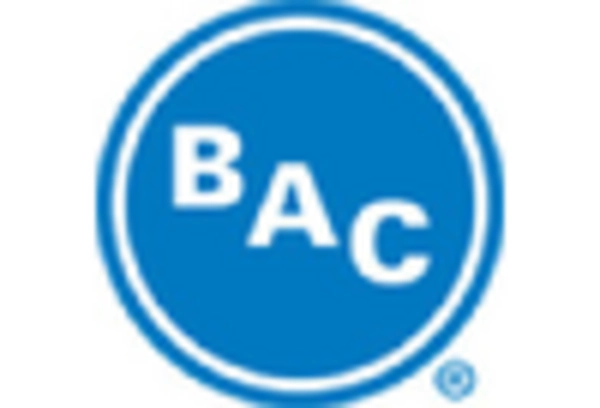
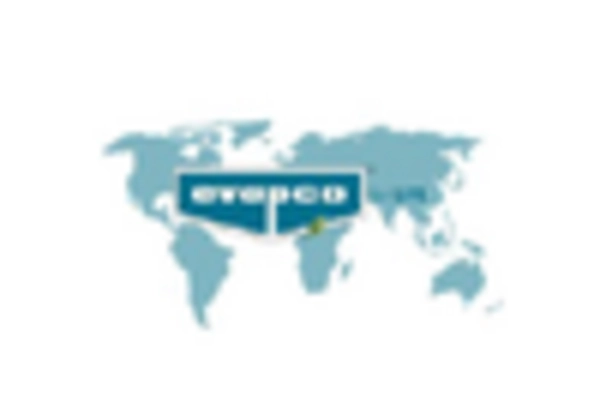

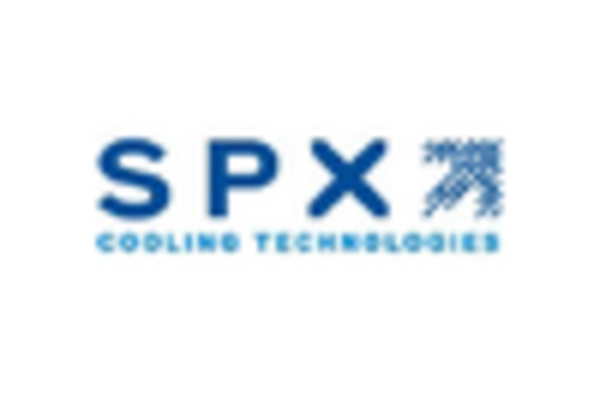
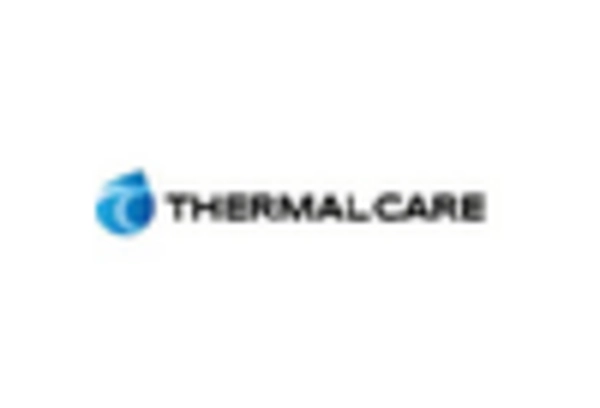
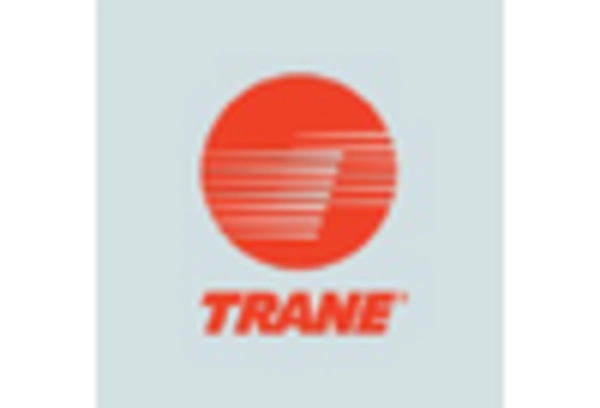
<p>The Cooling Tower Market is projected to grow at a 4.82% CAGR from 2024 to 2035, driven by increasing industrialization, energy efficiency demands, and technological advancements.</p>
New opportunities lie in:
<p>By 2035, the Cooling Tower Market is expected to achieve robust growth, reflecting evolving industry needs and technological innovations.</p>
| MARKET SIZE 2024 | 4009.54(USD Million) |
| MARKET SIZE 2025 | 4202.81(USD Million) |
| MARKET SIZE 2035 | 6729.63(USD Million) |
| COMPOUND ANNUAL GROWTH RATE (CAGR) | 4.82% (2024 - 2035) |
| REPORT COVERAGE | Revenue Forecast, Competitive Landscape, Growth Factors, and Trends |
| BASE YEAR | 2024 |
| Market Forecast Period | 2025 - 2035 |
| Historical Data | 2019 - 2024 |
| Market Forecast Units | USD Million |
| Key Companies Profiled | Market analysis in progress |
| Segments Covered | Market segmentation analysis in progress |
| Key Market Opportunities | Integration of advanced cooling technologies to enhance energy efficiency in the Cooling Tower Market. |
| Key Market Dynamics | Rising demand for energy-efficient cooling solutions drives innovation and competition in the cooling tower market. |
| Countries Covered | North America, Europe, APAC, South America, MEA |
What is the current valuation of the Cooling Tower Market as of 2024?
The Cooling Tower Market was valued at 4009.54 USD Million in 2024.
What is the projected market valuation for the Cooling Tower Market in 2035?
The market is projected to reach a valuation of 6729.63 USD Million by 2035.
What is the expected CAGR for the Cooling Tower Market during the forecast period 2025 - 2035?
The expected CAGR for the Cooling Tower Market during the forecast period 2025 - 2035 is 4.82%.
Which companies are considered key players in the Cooling Tower Market?
Key players in the Cooling Tower Market include SPX Cooling Technologies, Baltimore Air Coil, Evapco, and Trane, among others.
What are the main types of cooling towers and their market valuations?
The main types include Evaporative Cooling Towers valued between 2000.0 and 3500.0 USD Million, Dry Cooling Towers between 1200.0 and 2200.0 USD Million, and Hybrid Cooling Towers between 809.54 and 1029.63 USD Million.
How does the design segment of the Cooling Tower Market perform?
The Mechanical Draft design segment is valued between 2000.0 and 3500.0 USD Million, while the Natural Draft segment ranges from 2009.54 to 3229.63 USD Million.

Kindly complete the form below to receive a free sample of this Report

“This is really good guys. Excellent work on a tight deadline. I will continue to use you going forward and recommend you to others. Nice job”

“Thanks. It’s been a pleasure working with you, please use me as reference with any other Intel employees.”

“Thanks for sending the report it gives us a good global view of the Betaïne market.”

“Thank you, this will be very helpful for OQS.”

“We found the report very insightful! we found your research firm very helpful. I'm sending this email to secure our future business.”

“I am very pleased with how market segments have been defined in a relevant way for my purposes (such as "Portable Freezers & refrigerators" and "last-mile"). In general the report is well structured. Thanks very much for your efforts.”

“I have been reading the first document or the study, ,the Global HVAC and FP market report 2021 till 2026. Must say, good info! I have not gone in depth at all parts, but got a good indication of the data inside!”

“We got the report in time, we really thank you for your support in this process. I also thank to all of your team as they did a great job.”
Leave a Comment